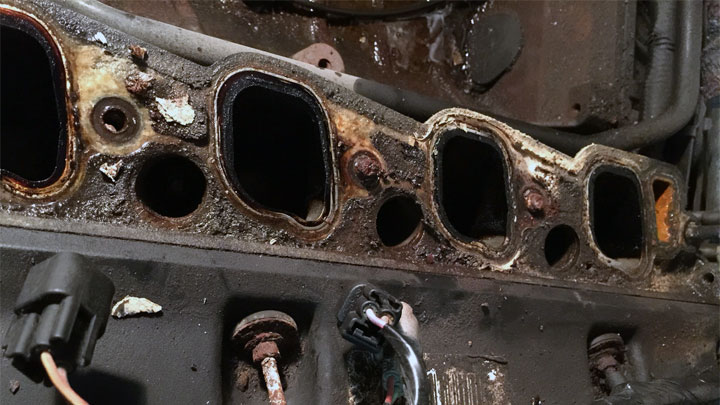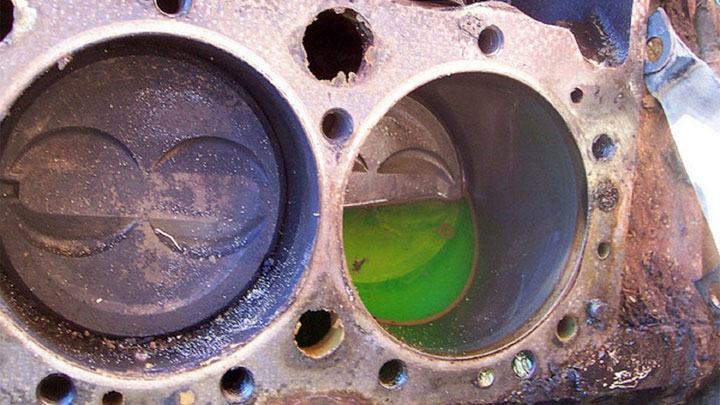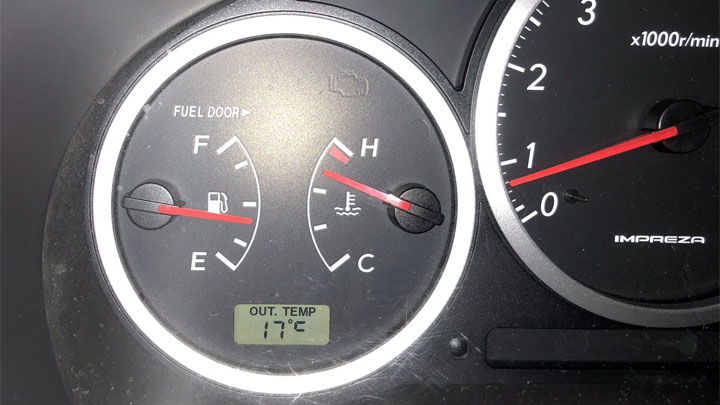8 Intake Manifold Leak Symptoms (and Replacement Cost)
Like blood through veins, air and fuel must flow unimpeded through your engine. But when the intake manifold gasket leaks, that vital circulation is disrupted. This sneaky issue causes subtle symptoms initially that signal serious trouble brewing.
Spot and fix gasket leaks early by learning the key symptoms of an intake manifold leak, what caused it, and how much it’ll cost to fix.

What Is an Intake Manifold Gasket?
The intake manifold gasket(s) sits between the cylinder head and the intake manifold. Its main purpose is to prevent coolant, oil, or air leaks.
Because of constant expansion and contraction from temperature changes, coolant and oil contamination, and the constant flow of intake air, the intake manifold gaskets can slowly break down and eventually get to the point where is deteriorates enough to cause a leak.
If a leak occurs, the gasket should be replaced as soon as possible to avoid potential engine damage or possibly getting stranded.
See Also: Oil in Your Intake Manifold? (Here’s What it Means)
Top 8 Symptoms of Intake Manifold Leak
#1 – Engine Coolant Leak

Engine coolant is sealed by an intake manifold gasket in the engine. If damage were to come to the seal, all the pressurized coolant it is holding back may seep through it.
Often times, the coolant will have debris and dirt inside of it which will create even more problems. If the debris is thick enough, it will cause more wear on the surfaces. Not only that, leaky coolant will also cause air from the outside to get into the engine through the seal.
Anytime oxygen is present, it will drastically increase the amount of corrosion that forms. This will cause even more damage to the surface.
See Also: Symptoms of a Bad Coolant Temperature Sensor
#2 – Overheated Engine

When coolant continues to leak, it will eventually cause the engine to overheat. But in some circumstances, the engine can still overheat even if the coolant does not appear to be leaking. Sometimes coolant will leak out of the intake manifold gasket and go right into the intake manifold, causing the engine to overheat.
On the outside, you would not see any signs of this leak. The only way you will know is when the engine starts to overheat and the temperature gauge in your dash rises to a high level. Then you can investigate and determine if this is the problem. If so, then get it fixed at an auto shop right away.
#3 – Engine Misfires
Engine misfires can be a frustrating issue, since they can be traced back to a variety of causes, and a leaking intake manifold may be one of them.
When an engine misfires due to a leaking intake manifold, it means that the extra air entering the combustion chamber is interfering with the combustion process. This disruption leads to irregular and incomplete burning of fuel, causing the engine to misfire. These misfires can manifest as sputtering or stumbling sensations while driving.
#4 – Rough Idle

When there is a leak in the intake manifold, unaccounted-for air can enter the system, disrupting the proper ratio of air and fuel needed for smooth engine operation. As a result, you may experience fluctuations in RPMs (revolutions per minute) and uneven performance at idle speed.
In addition, you may feel vibrations or hear unusual sounds coming from the engine bay when a rough idle exists.
#5 – Engine Backfires
A car engine that backfires is a concerning issue for any car owner. Not only are they embarrassing, they also raise questions about potential underlying problems. As with misfires and rough idle, a disruption or escape of the air-fuel mixture within the combustion chamber due to an intake manifold leak is to blame.
This disruption can lead to erratic combustion, resulting in a backfire. These noises might manifest as popping or even small explosions coming from the engine area.
#6 – Poor Acceleration

When there is a leak in the intake manifold, air can escape before it reaches the combustion chamber, leading to a decrease in the amount of air available for combustion.
This decrease in air supply can result in a decrease in engine power and acceleration. The engine may struggle to reach higher speeds or may take longer to get up to speed. Additionally, the engine may feel sluggish or unresponsive when accelerating, even when the gas pedal is pressed down.
#7 – Reduction in Gas Mileage
On the other end of it, if too much air makes its way into the combustion chamber due to an intake manifold leak, the car’s ECM will attempt to compensate by sending more fuel than is necessary. This will result in the vehicle running rich and you having to spend more money at the pump.
#8 – Stalling

With an air-fuel mixture imbalance, your vehicle may unexpectedly stall while driving. While in most cases you should be able to start the engine back up, it can nonetheless become a dangerous situation and it’s important not to panic if this occurs.
Intake Manifold Gasket Replacement Cost
Best places to order parts? See: 19 Best Online Auto Parts Stores

The intake manifold gasket is maybe the most expensive gaskets in a car due to its durability requirement and unique shape. A new replacement gasket will likely run you somewhere in the range of $50 to $120 which doesn’t sound so bad.
But the expensive portion will be the work required to replace it since it’s not easy to get to. Because it often takes 2-3 hours to replace, the labor cost to replace an intake manifold gasket will set you back about $250 to $500. This number could even be higher for sports cars and luxury vehicles.
All together, on average you can expect to pay around $300 to $620 for the total cost of an intake manifold gasket replacement.
Read Also: Oil Pan Gasket Replacement Cost
Causes of Intake Manifold Leaks

Damaged Gasket
The gasket that seals your intake manifold can wear out, crack, or become damaged over time. This can lead to air or coolant leaks, causing various problems such as the one listed above. Car manufacturers don’t typically have a replacement schedule for intake manifold gaskets so they are usually only replaced after a leak develops.
Cracked Intake Manifold
A cracked intake manifold is another common cause of leaks. When your intake manifold has a crack or a hole, extra air can get into the combustion chamber, resulting in air/fuel ratio related issues like misfires.
Continually driving with a cracked intake manifold can lead to more significant issues, so it’s important to get it fixed as soon as you notice any symptoms.
Loose Components
Loose or disconnected components can also cause intake manifold leaks. If bolts securing the intake manifold become loose or vacuum hoses get disconnected or damaged, air can leak into the system. Regularly check and tighten any loose components and replace damaged hoses to avoid leaks and ensure proper engine function.
Troubleshooting an Intake Manifold Leak
If engines have aluminum cylinder heads on them, you can expect to have corrosion near the ports of the coolant. The intake manifold gasket’s seal bead has plastic under it that may be eaten away as well.
If you see this, then it means the seal will not hold and will be susceptible to leakage. As a result, the gasket would not be the cause of the leak in this case.
Testing for an intake manifold leak should not be attempted by novice mechanics and in most cases you should let a professional handle it. That said, here are the general processes.
Coolant Leak Testing
If coolant leaks on the outside of the gasket, then you can see it with your own two eyes. But if there are internal leaks which cause the coolant to flow into the oil or combustion chamber, then you won’t be able to spot them that easily.
What you’ll want to do is give your system a complete inspection. Start by checking the oil for signs of foaming or other types of contamination. You should also pull the codes so you know exactly what you’re dealing with.
If the codes relate to the oxygen or efficiency sensor, then it means that coolant has gotten into the combustion chamber. Since phosphates are found in the coolant, along with other chemicals, this will cause damage to the catalytic converter and the oxygen sensor.
If you have a V8 or V6 engine, you can use the codes to figure out which bank has the leak. Any big leaks that are in the runner may give you a misfire code. If you experience this problem for extended periods of time, take out all the spark plugs in your vehicle.
See if the electrodes have any chalky white deposits on them because this is the markings that coolant will leave on them. By following these techniques, it will help you determine where the leak is coming from and if more tests need to be done, such as leak down checks or compression checks.
Related DTCs: P2004 Code, P2006 Code, P2279 Code
Air Leak Testing
A fuel trim problem can occur if the intake manifold has the even the tiniest vacuum leak. If you just use your eyes and ears to find the leak, it will become very time-consuming.
Anytime air leaks through the intake manifold, it will cause air to get sucked in rather than pushed out. Whatever is in the air that’s pulled in will compromise the mixture of the fuel and air, which will impact the emission system and the engine system.
If you have a smoke machine, then multiple leaks can be diagnosed in a shorter amount of time. This machine does this by allowing the intake manifold to become pressurized while placing vapor and smoke into the system. So, if a leak truly does exist, then smoke will be drawn out.
Find a vacuum port and attach the smoke machine to it just like you would have the brake booster connected to the supply line. Ensure that you have the right sized plug when blocking the throttle body. You’ll also want the PCV system to be blocked off as well.
If the PCV system or oil filter has smoke coming out of it and the engine is not misfiring, then it probably means there is a crack or leak underneath the intake manifold. It may also mean the valve seals or guides are too worn out.
Is It Safe to Drive With a Leaking Intake Manifold?
While it may be possible to drive for a short distance, it is not recommended in the long run. Intake manifold leaks can cause performance issues, such as misfires and reduced power and fuel efficiency. But more importantly, they can also disrupt the coolant system, potentially leading to overheating and engine damage.
If you notice coolant leaks or compromised gaskets, it’s best to have a professional mechanic inspect and fix the problem as soon as possible.
- Replace the Engine or Replace the Car? (11 Factors to Consider) - Apr 11, 2024
- Plastic Piece Dragging Under Your Car? (What It Is and What To Do) - Mar 21, 2024
- Timing Belt vs Timing Chain (What’s the Difference?) - Feb 27, 2024

I have a 1998 dodge avenger. Paid mechanic to replace flywheel. When all put back together. Car ran wide open & sounded like a lawn mower. He did not replace my manifold gasket or clean manifold. He said gasket was good. Replaced sensor. Still running wide open
Sounds like there may be an exhaust leak somewhere, if I’m understanding “running wide open” correctly. Is the vehicle louder than it was before?
Manifold assy-intake for my nissan patrole 2014 damged during start up and creat big hole.
I replace the whole manifold assy and car back to normal.
what you think the cause of this damage?
Hassan
I have no idea. Are you saying the first startup after replacing the intake created a hole?
I don’t know why people always expect mechanics to work for free… if you screw up at work does your boss get to make you come in and redo it for free on your days off?
A Subaru with 160K on the clock and engine problems is fit for the junkyard– the mechanic shouldn’t have even been willing to work on it… just a waste of money and (obviously) all drama.
Mechanics have a right to refuse work if the vehicle is unsafe or they think it will cause them a lot of problems. However, they should try to do the job right the first time. If they make a mistake, they should make it right. Most good mechanics do, in my experience.
A Subaru with 160k on the clock and engine problems still has plenty of life left in the right hands. I’ve saved a Subaru with 260k on the clock and blown head gaskets. It’s still out there on the road somewhere on its way to 300k miles.
What’s the price to fix a intake manifold leak on a 2003 Lincoln town house??
Desperately in need of advice:
Suppose you perform a head gasket job on a 2004 Outback (Subaru) after the car overheats and the radiator cracks. Only 24 hours after the shop completes the work the belts drop and bend valves at highway speed, causing the entire job to be repeated (and then some). The car is driven for five months while it continues to leak a small amount of oil onto the driveway. The same shop replaces the lower crankshaft seal (at cost to customer) to resolve oil leak. Not long after that, a check engine light comes on. Shop owner reads a “P1092” code, which he says makes no sense as that code on a Subaru is reserved for a “tumble generator valve”, which he says corresponds to a WRX but not to an Outback. Customer pulls car from shop and takes it to dealer, where dealer reads the same code and is also baffled. Dealer eventually concedes that the “tumble generator valve” exists after all but upon replacing it, the CEL does not clear. Customer later learns that the actual part that is installed by dealer is not called a “tumble generator valve” but a “Fuel Injection Idle Air Control Valve” (Subaru part 14120AA020). After the CEL does not clear, dealer removes part and then informs customer that they need to pay almost a thousand dollars to clean the intake manifold. Original mechanic continues to insist that the ECU is bad and rejects the notion that the intake manifold requires cleaning.
Is the customer impression correct: Intake manifold repair should be covered by the shop owner’s 2x head gasket job, less than one year prior, on the basis that the head gasket could not be accessed without tear-down of the aforementioned intake manifold. At that time, should not the intake manifold have been cleaned of carbon and/or debris created when the belts dropped and the valves bent? Moreover, at that time, should not the intake manifold gasket have also been inspected and replaced since the car had over 160,000 miles on it?
Customer checked records and does not see any indication that in the course of doing the 2x head gasket work that the intake gasket was replaced. Is it possible that the P1092 code corresponds not to a failing “tumble generator valve” or even “carbon deposits” in the manifold but a failing gasket (i.e. a bad seal)?
The symptom that occurred with the P1092 code was failure of the car to accelerate properly at low speeds (difficulty getting the car up to highway speed). Could this kind of drivability problem be created by A) a “tumble generator valve” in a 4 cylinder Outback, B) a failing intake manifold seal, or C) carbon buildup in the manifold, or D) debris that accumulated in the intake manifold after the valves bent?
The bottom line from the customer perspective is whether or not this is a NEW problem for which it is necessary to fork over another thousand dollars OR if the shop owner should take responsibility for resolving the problem since these engine components had to be disassembled less than a year ago to make way for the back-to-back head gasket repair jobs.
That’s a tough one. As a disclaimer, I am not a professional mechanic and have never been in this situation, but I will do my best to help.
Was the engine pulled as part of the head gasket job? You can do the head gaskets on these cars by jacking up the motor so the heads clear the body instead of removing it, but many people find it easier to just pull the whole thing out of the car.
If the leaking seal was easily accessible during the head gasket job and the customer was not informed that it should be replaced, this seems like a mistake on the shop’s part. The front crank seal is accessible regardless of whether or not the engine is in the car. If the motor was pulled, I would expect the shop to replace the rear main seal or at least run it by the customer, and have them sign off on it if they opted not to have the shop replace the seal.
I feel the same about the intake manifold gaskets, which should have been replaced.
I am almost certain these Outbacks do not have TGVs. However, if the code was thrown very soon after the crank seal was replaced, I am inclined to believe it was caused by the work that was done (despite being seemingly unrelated). I would be pleased with a shop that performed the diag at no cost to the customer as a goodwill gesture. If the root cause is determined to be unrelated to prior work, the customer should pay for the actual repair.
Look on the internet for the repair manual pdf for your car and read the complete instructions for changing the head gasket on the engine you have in your car. It will tell you exactly what should have been done, gaskets replaced and cleaning of parts. In my opinion they should have asked you if you wanted the timing chains replaced as a precaution while they had it all apart. Repair manuals can be a handy read anyway as it will give you more knowledge about your car and possibly prevent you being ripped off by unscrupulous mechanics
Yes. He screwed you. That intake gasket should’ve been replaced when it was out. Period. Full stop. Especially at 160k on the dash! He should’ve known better.
Your failure to accelerate at low speeds is almost certainly due to extra air being pulled in through your leaky intake manifold. The engine is probably running super lean, and therefore can’t make the power it needs to get you off the line. Fight this. Go get an opinion from a licensed mechanic you trust, ask him if he’d mind signing an affidavit, and sue that pos.
Keep in mind, however, that I’m flying blind here and can’t be 100% certain that this is the exact cause of your problem. That being said, if all the information you’ve provided here is accurate to the letter, that man screwed you, and the dealership is just grabbing at straws because they don’t want to invest the time in properly diagnosing your car. I’ve seen it a hundred times. They’re often very lazy.